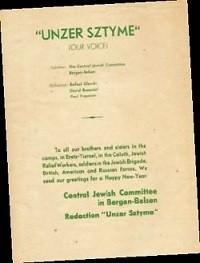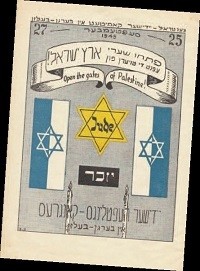Stories of Jewish Survival
A 68-year-old handwritten Yiddish language magazine, page edges slightly crumbling and the colors now varying hues of the original, having gradually faded over the years, is gently placed before me on a low coffee table by Aviram Paz, a well-known avid collector of Jewish memorabilia – particularly from the First and Second World War periods.
Named Unzer Sztyme (Our Voice), this particular publication was the third edition of that magazine prepared and printed in 1947 by Holocaust survivors billeted in Bergen-Belsen, after the notorious extermination camp became a center for displaced persons following liberation by British Armed Forces in April, 1945.
On the table is a special issue of Our Voice, celebrating the up and coming Jewish holidays of Rosh Hashanah, Yom Kippur and Succot, with articles, prose, fine artwork, photographs and holiday greetings.
Articles and illustrations were written and drawn by survivors, with additional content sent from European and Israeli community leaders and representatives of organizations set up in order to assist and resettle Holocaust survivors.
A message from the Central Jewish Committee in Bergen-Belsen, written both in Yiddish and in English on the inside back page, reads:
"To all our brothers and sisters in the camps, in Eretz-Yisroel, in the Goluth, Jewish Relief Workers, soldiers in the Jewish Brigade, British, American and Russian Forces. We send our greetings for a Happy New Year."
One of the articles deals with the Yiddish Theater founded at Bergen-Belsen under the leadership of Sami Feder, another addresses Israeli emissary-led activities of various movements as well as commentaries about and a reproduction of a poster for the 25–27 September 1945 Congress of Displaced Persons held at Bergen-Belsen – the powerful graphics headed with a demand to the British (written in Yiddish, Hebrew and English) to 'Open the gates of Palestine'.
Neatly folded, still unread and in pristine condition, a copy of an Israeli weekly Hebrew newspaper also sits on the same coffee table – just a few inches away from the almost seven-decades-old special holiday edition of the 1940s collective voice of Bergen-Belsen Displaced Persons camp residents.
It is more than likely that within the next few days the daily newspaper will end up in a recycling bin, whilst on the other hand, the lovingly kept and cared-for Yiddish language magazine from almost 70 years ago will be returned to its special envelope and kept in regulated temperature storage.
The two publications sit side by side on the table – the same Hebrew letters used for the penning of two very different languages, one that is slowly disappearing, and the other that is spoken in modern times by more than 8 million Jews, Arabs and others in Israel and millions more elsewhere in the world, had a profound effect on this British-born Israeli writer, whose elderly Jewish orthodox paternal grandparents had immigrated from Poland to South Wales in the early 1900s, and whose everyday language at home in the coal mining town of Ystrad Mynach, had been Yiddish.
Almost 50 years after making aliyah, rarely hearing and never understanding Yiddish, Hebrew however became the language of communication between the writer, her secular kibbutz community, late spouse, five children and many grandchildren – the very same language the paternal grandparents would have used only when reading Torah and praying in their Polish and Welsh synagogues.
Such is the aleph-bet of the wandering Jews.
Aviram Paz, the Israeli-born collector of Jewish yesteryear, taught himself Yiddish. As he very carefully turned the pages of Our Voice, he explained about some of the texts, artwork and photographs contained in that edition.
Slowly, the work of the Bergen-Belsen magazine creators became even more powerful – overwhelmingly so – as one understood the depth of the miracle that having survived the most heinous crimes against humanity, survivors came together, discovered their individual strengths, creativity and sheer determination to collectively move forward and to rebuild broken lives, families and communities.
"The publication was printed on a hectograph, a tedious process with additional ink needing to be added after every 15 copies of a page," Paz explains.
On some pages the handwriting is in a much bolder print, apparently all down to how deep the cut was made when making up the sheet of thin rubber/lino used in preparation prior to being wrapped around the hectograph.
Prisoners of war at Stalag Luft 111 and Colditz Castle used an improvised hectograph during World War II to reproduce documents for their planned escape. Nowadays forms of hectograph printing have made a comeback in the world of art.
Another 1940s publication, Netzach Yisrael, was produced at a displaced persons camp in Munich run by the Joint and other organizations.
Paz places a 1948 issue of Netzach Yisrael alongside that of Our Voice, where a fuzzy photograph of two Jews standing in a ploughed field in Israel appears on the front cover, but with no mention of who or where they are in the country.
"In this publication we see more articles from rabbis than in the Our Voice issue. One of the articles is penned by Rabbi Ben Zion Meir Chai Uziel, Chief Rabbi of Israel at the time, and Rabbi Meir Berline, the Chief Rabbi of the European Mizrachi movement, who write in depth about the 10-day period between Rosh Hashanah and Yom Kippur. In his article Rabbi Unterman of Tel Aviv puts his pen to paper, encouraging good deeds.
There are two grainy photographs side by side. In one, a sad-faced young boy with a book tucked under his arm and a flat cloth cap pulled down to his ears, looks up as a number of heavily bearded Orthodox Jews behind him speak with military personnel in a displaced persons camp.
The other shows a group of painfully thin-faced children poring over books around a wooden table in a forecourt. The photographs are magnetic, almost physical, yanking one back in time.
One yearns to give the little boy with the sad face a hug and to dish out some tender loving care for the boys with their pants falling down as they half-sit, half-stand around the study table.
After leaving the displaced persons camps, many survivors, especially those who had become members of Zionist movements, boarded rickety ships for a clandestine voyage to British Mandatory Palestine where they hoped to start a new life – if they could get through the British blockade.
In a large album with clear plastic pockets sit two very striking Rosh Hashanah cards – both black and white with Hebrew letters, and both with drawings or photographs of ships heading for the Promised Land or anchored in Haifa Port after capture by the British.
Staring out of a round cutout in one of the cards, a mother and child look seriously toward the camera – they were among those whom the British captured and sent off to a detention camp in Cyprus.
"It is very difficult to believe that photographers saw an opportunity of making money by offering their services to these poor people, but it also shows how important it was to them to have a personal Rosh Hashanah greeting card and also, basically, a momento of the circumstances they found themselves in," explains Paz.
"In Cyprus, photographers waited at the entrance to the camps with a selection of cards for the detainees to choose from, and mounted their photographs on the chosen illustration.
"In Haifa port photographers from Photo Studio Kougel stood on the dock and took photos of the people and the ships, and if requested, created appropriate cards from their stills."
Some of the detained would-be-immigrants were taken to the British detention center at Atlit, a short journey along the coastline from Haifa port, whilst others were shipped to Cyprus.
However, there were those who managed to 'disappear' in all the confusion at the docks, sometimes whipped away by relatives meeting each ship, searching for their near and dear ones.
"These people or their relatives, would be the ones that would later turn up to purchase the photographs from Studio Kougel in downtown Haifa," concluded Paz, gently closing the album.
Each and every one of the scores of Rosh Hashanah cards in the album keep alive an important part of the story of thousands of desperate people trying to regain a sense of normality and show pride in who they are as they celebrate a Jewish holiday, even though still behind barbed wire fences, whether in Atlit or Cyprus, waiting for their freedom and hoping to have the promise of a Shana Tova fulfilled.











Comments